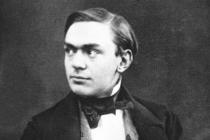Subject. Systems theory queuing.
Each QS consists of a certain number of service units, which are calledservice channels (these are machine tools, transport carts, robots, communication lines, cashiers, sellers, etc.). Every QS is designed to serve someapplication flow (requirements) arriving at some random time.
QS classification according to the method of processing the input stream of applications.
Queuing systems
With rejections
(no queue)
With a queue
limited queue
with priority
In order of arrival
Relative Priority
Absolute priority
By service time
By queue length
Classification by way of functioning:
open, i.e. the flow of requests does not depend on the internal state of the QS;
closed, i.e. the input flow depends on the state of the QS (one maintenance worker services all channels as they fail).
Multichannel QS with waiting
A system with a limited queue length. Consider channel QS with waiting, which receives a flow of requests with intensity ; service intensity (for one channel) ; number of places in line
The system states are numbered according to the number of applications, system-related:
no queue:
- all channels are free;
- one channel is occupied, the rest are free;
- busy -channels, the rest are not;
- everyone is busy - no free channels;
there is a queue:
- all n-channels are occupied; one application is in the queue;
- all n-channels are occupied, r-requests in the queue;
- all n-channels are occupied, r-requests in the queue.
GSP is shown in fig. 9. Each arrow has corresponding intensities of event flows. According to the arrows from left to right, the system is always transferred by the same flow of applications with intensity , according to the arrows from right to left, the system is transferred by the service flow, the intensity of which is equal to multiplied by the number of busy channels.
Rice. 9. Multichannel QS with waiting
Failure probability.
![]() (29)
(29)
The relative throughput complements the failure probability to one:
![]()
Absolute throughput of QS:
![]() (30)
(30)
Average number of busy channels.
The average number of requests in the queue can be calculated directly as the mathematical expectation of a discrete random variable:
 (31)
(31)
Where .
Here again (expression in brackets) the derivative of the sum of a geometric progression occurs (see above (23), (24) - (26)), using the ratio for it, we get:
![]()
Average number of applications in the system:
Average waiting time for an application in the queue.
 (32)
(32)
Just as in the case of a single-channel waiting QS, we note that this expression differs from the expression for the average queue length only by the factor , i.e.
![]() .
.
Average residence time of an application in the system, the same as for a single-channel QS ![]() .
.
Systems with unlimited queue length. We have reviewed channel QS with waiting, when no more than m-requests can be in the queue at the same time.
Just as before, when analyzing systems without restrictions, it is necessary to consider the relations obtained for .
Failure Probability
The average number of applications in the queue will be obtained at from (31):
![]() ,
,
and the average waiting time is from (32): ![]() .
.
Average number of applications .
Example 2 Gas station with two columns (n = 2) serves the flow of cars with intensity =0.8 (cars per minute). Average service time per machine:
![]()
There is no other gas station in the area, so the queue of cars in front of the gas station can grow almost indefinitely. Find the characteristics of the QS.
CMO with limited time expectations. Previously, we considered systems with waiting limited only by the queue length (the number of m-customers simultaneously in the queue). In such a QS, a claim that has grown into a queue does not leave it until it waits for service. In practice, there are QS of another type, in which the application, after waiting for some time, can leave the queue (the so-called "impatient" applications).
Consider a QS of this type, assuming that the waiting time constraint is a random variable.
Poisson "flow of escapes" with intensity:
If this flow is Poisson, then the process occurring in the QS will be Markov. Let us find the probabilities of states for it. The numbering of system states is associated with the number of requests in the system - both served and queued:
no queue:
- all channels are free;
- one channel is busy;
- two channels are occupied;
- all n-channels are occupied;
there is a queue:
- all n-channels are occupied, one request is in the queue;
- all n-channels are occupied, r-requests are in the queue, etc.
The graph of states and transitions of the system is shown in fig. 10.

Rice. 10. CMO with limited waiting time
Let's label this graph as before; all arrows leading from left to right will have the intensity of the flow of applications . For states without a queue, the arrows leading from them from right to left will, as before, have the total intensity of the service flow of all busy channels. As for the states with a queue, the arrows leading from them from right to left will have the total intensity of the service flow of all n-channels plus the corresponding intensity of the dequeue flow. If there are r-entries in the queue, then the total intensity of the flow of departures will be equal to .
Average number of applications in the queue: (35)
For each of these requests, there is an “exit flow” with an intensity . So from the average - applications in the queue will leave on average without waiting for service, -applications per unit of time and total per unit of time will be served on average - applications. The relative throughput of the QS will be: ![]()
Average Busy Channels is still obtained by dividing the absolute throughput of A by Closed QS
So far, we have considered systems in which the incoming flow is not connected in any way with the outgoing one. Such systems are called open. In some cases, the serviced requests, after a delay, again enter the input. Such QS are called closed. A polyclinic serving a given area, a team of workers assigned to a group of machines, are examples of closed systems.
In a closed QS, the same finite number of potential requirements circulate. Until a potential requirement has been realized as a service requirement, it is considered to be in a delay block. At the time of implementation, it enters the system itself. For example, workers serve a group of machines. Each machine is a potential requirement, turning into a real one the moment it breaks down. While the machine is running, it is in the delay unit, and from the moment of breakdown until the end of the repair, it is in the system itself. Each worker is a service channel. = =P 1 + 2 P 2 +…+(n- 1 )P n- 1 +n( 1 -P The input of a three-channel QS with failures receives a flow of applications with an intensity \u003d 4 requests per minute, time for servicing an application by one channelt service=1/μ =0.5 min. Is it advantageous from the point of view of QS throughput to force all three channels to serve applications at once, and the average service time is reduced by a factor of three? How will this affect the average time an application spends in the CMO?
Example 2 . /µ=2, ρ/n =2/3<1.
Task 3:
Two workers serve a group of four machines. Stops of a running machine occur on average after 30 minutes. The average setup time is 15 minutes. Operating time and setup time are distributed exponentially.
Find the average share of free time for each worker and the average time the machine is running.
Find the same characteristics for a system where:
a) two machines are assigned to each worker;
b) two workers always serve the machine together, and with double intensity;
c) the only faulty machine is served by both workers at once (with double intensity), and when at least one more faulty machine appears, they begin to work separately, each serving one machine (first, describe the system in terms of death and birth processes).
The system receives a Poisson flow of requirements with intensity λ, the service flow has intensity μ, the maximum number of places in the queue is T. If a claim enters the system when all places in the queue are filled, it leaves the system unserved.
The final probabilities of the states of such a system always exist, since the number of states is finite:
S 0 – the system is free and is idle;
S 1 - one request is served, the channel is busy, there is no queue;
S 2 - one application is served, one is in the queue;
S m +1 - one application is served, T queue.
The state graph of such a system is shown in Figure 5:
S 0 S 1 S 2 S m+1
μ μ μ ………. μ μ
Figure 5: Single-channel QS with limited queue.
In the formula for R 0 find the sum of a finite number of members of a geometric progression:
 (52)
(52)
Taking into account the formula for ρ, we obtain the expression:
There are (m+2) elements of a geometric progression in parentheses with the first member 1 and the denominator ρ. According to the formula for the sum (m + 2) of the members of the progression:
 (54)
(54)
 (55)
(55)
The formulas for the probabilities of limit states will look like:
Denial of Service Probability We define a request as the probability that when a request enters the system, its channel will be occupied and all places in the queue are also occupied:
 (57)
(57)
Hence the service probability(as well as from carrier bandwidth) are equal to the probabilities of the opposite event:
Absolute Bandwidth is the number of requests served by the system per unit of time:
 (59)
(59)
Average number of requests under service:
 (60)
(60)
 (61)
(61)
Average number of applications in the system:
 (62)
(62)
A single-channel QS with a limited queue can be considered in Mathcad.
Example:
The parking lot serves 3 cars with a flow rate of 0.5 and an average service time of 2.5 minutes. Determine all indicators of the system.

6 Multi-channel smoo with unlimited queue
Let a system S be given that has P service channels that receive the simplest flow of requests with intensity λ. Let the service flow also be the simplest and have intensity μ. The queue for service is not limited.
By the number of applications in the system, we denote the states of the system: S 0 ,S 1 ,S 2 ,…,S k ,… S n , where S k – the state of the system when there are k requests in it (the maximum number of requests under service is n). The state graph of such a system is depicted as a diagram in Figure 6:
λ λ λ λ λ λ λ
……. …….
S 0 S 1 S 2 S m+1 S n
μ 2μ 3μ ………. kμ (k+1)μ …… nμ nμ
Figure 6: Multichannel QS with unlimited queue.
The intensity of the flow of services varies depending on the state of the system: kμ upon transition from the state S k to the state S k -1 since any of the k channels; after all channels are occupied with service, the intensity of the flow of services remains equal to pμ, upon receipt of the following applications in the system.
To find the final probabilities of states, we obtain formulas similar to how it was done for a single-channel system.
 (63)
(63)
Hence the formulas for the final probabilities are expressed in terms of
For finding R 0 we get the equation:
For the terms in brackets, starting from the (n + 2)th, you can apply the formula for finding the sum of an infinitely decreasing geometric progression with the first term  and denominator ρ/n:
and denominator ρ/n:
 (66)
(66)
Finally, we obtain the Erlang formula for finding the probability of system downtime:
 (67)
(67)
Let us give formulas for calculating the main indicators of the efficiency of the system.
The system will cope with the flow of requests if
condition
 ,
(68)
,
(68)
which means that the number of requests received by the system per unit of time does not exceed the number of requests served by the system during the same time. Wherein probability of denial of service equals zero.
From here service probability(as well as relative throughput systems) are equal to the probabilities of the opposite event, that is, to unity:
 (69)
(69)
Absolutethroughput- the number of applications served by the system per unit of time:
 (70)
(70)
If the system copes with the flow of applications, then in stationary mode outflow rate is equal to the intensity of the flow of requests entering the system, since all requests are serviced:
ν=λ . (71)
Since each channel serves μ requests per unit of time, then average busy channels can be calculated:
 (72)
(72)
Averagetimeservice one application channel ;
 .
(73)
.
(73)
The probability that, upon entering the system, an order will end up in a queue is equal to the probability that there are more than P applications:
 (74)
(74)
The number of applications under service, is equal to the number of busy channels:
 (75)
(75)
Average number of applications in the queue:
 (76)
(76)
Then averagenumberapplicationsin system:
 (77)
(77)
Average residence time of an application in the system (in the queue):
 (78)
(78)
 (79)
(79)
A multi-channel QS with an unlimited queue can be considered in the Mathcad system.
Example 1:
The hairdressing salon has 5 masters. At rush hour, the intensity of the flow of customers is 6 people. At one o'clock. Service of one client lasts an average of 40 minutes. Determine the average length of the queue, assuming it is unlimited.
Fragment of solving the problem in Mathcad.

Example 2:
The railway ticket office has 2 windows. Time to serve one passenger is 0.5 minutes. Passengers approach the ticket office in groups of 3. Determine all characteristics of the system.
Fragment of solving the problem in Mathcad.

Continuation of the solution of the problem in Mathcad.

In practice, one-channel QS with a queue is quite common (a doctor serving patients; a pay phone with one booth; a computer fulfilling user orders). In the theory of queuing, single-channel QS with a queue also occupy a special place (most of the analytical formulas obtained so far for non-Markovian systems belong to such QS). Therefore, we will pay special attention to single-channel QS with a queue.
Let there be a single-channel QS with a queue on which no restrictions are imposed (neither on the length of the queue, nor on the waiting time). This QS receives a flow of applications with intensity λ; the flow of services has an intensity μ that is inverse to the average service time of the request tb. It is required to find the final probabilities of the QS states, as well as the characteristics of its efficiency:
Lsyst - the average number of applications in the system,
Wsyst is the average residence time of an application in the system,
Loch - the average number of applications in the queue,
Woch - the average time the application stays in the queue,
Rzan - the probability that the channel is busy (the degree of channel load).
As for the absolute throughput A and relative Q, there is no need to calculate them: due to the fact that the queue is unlimited, each application will be served sooner or later, therefore A = λ, for the same reason Q = 1.
Solution. The states of the system, as before, will be numbered according to the number of applications in the QS:
S0 - channel is free,
S1 - the channel is busy (serves the request), there is no queue,
S2 - the channel is busy, one request is in the queue,
Sk - the channel is busy, k - 1 requests are in the queue.
Theoretically, the number of states is not limited by anything (infinitely). The state graph has the form shown in Fig. 4.11. This is a scheme of death and reproduction, but with an infinite number of states. For all arrows, the flow of requests with intensity λ transfers the system from left to right, and from right to left - the flow of services with intensity μ.
Rice. 4.11. Graph of QS states in the form of a scheme of death and reproduction with an infinite number of states
First of all, let us ask ourselves, are there final probabilities in this case? After all, the number of system states is infinite, and, in principle, as t→∞, the queue can grow indefinitely! Yes, it is true: the final probabilities for such a QS do not always exist, but only when the system is not overloaded. It can be proved that if p is strictly less than one (p<1), то финальные вероятности существуют, а при р ≥ 1 очередь при t →∞ растет неограниченно. Особенно «непонятным» кажется этот факт при р = 1. Казалось бы, к системе не предъявляется невыполнимых требований: за время обслуживания одной заявки приходит в среднем одна заявка, и все должно быть в порядке, а вот на деле - не так. При р = 1 СМО справляется с потоком заявок, только если поток этот - регулярен, и время обслуживания - тоже не случайное, равное интервалу между заявками. В этом «идеальном» случае очереди в СМО вообще не будет, канал будет непрерывно занят и будет регулярно выпускать обслуженные заявки. Но стоит только потоку заявок или потоку обслуживаний стать хотя бы немного случайными - и очередь уже будет расти до бесконечности. На практике этого не происходит только потому, что «бесконечное число заявок в очереди» - абстракция. Вот к каким грубым ошибкам может привести замена случайных величин их математическими ожиданиями!
But let's get back to our single-channel QS with an unlimited queue. Strictly speaking, the formulas for the final probabilities in the scheme of death and reproduction were derived by us only for the case of a finite number of states, but we will use them for an infinite number of states as well. Let us calculate the final probabilities of states according to formulas (4.21), (4.20). In our case, the number of terms in formula (4.21) will be infinite. We get the expression for p0:
whereThe probabilities p1, p2, ..., pk, ... can be found by the formulas:
whence, taking into account (4.38), we finally find:
p 1 = ρ(1 - ρ), = ρ2(1- ρ), . . ., pk= ρ4(1- ρ), . . . (4.39)
As you can see, the probabilities p0, p1, ..., pk, ... form a geometric progression with the denominator p. Oddly enough, the maximum of them p0 is the probability that the channel will be free at all. No matter how loaded the system with the queue is, if only it can cope with the flow of applications at all (p<1), самое вероятное число заявок в системе будет 0.
Let us find the average number of applications in the QS Lsyst. Random variable Z - the number of applications in the system - has possible values 0, 1, 2, ..., k, ... with probabilities p0, p1, p2, ..., pk, ... Its mathematical expectation is equal to
| |

(the sum is taken not from 0 to ∞, but from 1 to ∞, since the zero term is equal to zero).
Let us substitute into formula (4.40) the expression for рk (4.39):

Now we take p (1 - p) out of the sign of the sum:
![]()
Here we again apply the “little trick”: kpk-1 is nothing more than the derivative with respect to p of the expression pk; Means,
![]()
By interchanging the operations of differentiation and summation, we get:
Well, now let's apply Little's formula (4.25) and find the average residence time of an order in the system:
| |
Find the average number of applications in the queue Loch. We will argue as follows: the number of applications in the queue is equal to the number of applications in the system minus the number of applications under service. This means (according to the rule of addition of mathematical expectations), the average number of applications in the queue Lch is equal to the average number of applications in the system Lsyst minus the average number of applications under service. The number of requests under service can be either zero (if the channel is free) or one (if it is busy). The mathematical expectation of such a random variable is equal to the probability that the channel is busy (we denoted it as Rzan). Obviously, Pzan is equal to one minus the probability p0 that the channel is free:
![]()
and finally
Thus, all characteristics of QS efficiency have been found.
Let's suggest the reader to solve an example on his own: a single-channel QS is a railway marshalling yard, which receives the simplest flow of trains with an intensity of λ = 2 (trains per hour). Maintenance (disbandment) of the composition lasts a random (demonstrative) time with an average value of tb = 20 (min.). In the station's arrival park, there are two tracks on which arriving trains can wait for service; if both tracks are busy, the trains are forced to wait on the outer tracks. It is required to find (for the limiting, stationary mode of operation of the station): the average number of trains Lsist associated with the station, the average time Wsist of the train stay at the station (on internal tracks, on external tracks and under maintenance), the average number Lch of trains waiting in line for disbandment (it doesn’t matter on which tracks), the average time Wch of the train staying in line. In addition, try to find the average number of trains waiting to disband on external tracks Lext and the average time of this waiting Wext (the last two values are related by Little's formula). Finally, find the total daily fine W, which the station will have to pay for demurrage of trains on external tracks, if the station pays fine a (rubles) for one hour of demurrage of one train. Just in case, we report the answers: Lcist = 2 (composition), Wsyst = i (hour), Loch = 4/3 (composition), Woch = 2/3 (hours), Lext = 16/27 (composition), Wext = 8/27 ≈ 0.297 (hours). The average daily fine W for waiting for trains on external tracks is obtained by multiplying the average number of trains arriving at the station per day, the average waiting time for a train on external tracks and the hourly penalty a: W ≈ 14.2a.
Multi-channel QS with unlimited queue
Let's consider the task. Available n-channel QS with unlimited queue. The flow of applications entering the QS has an intensity l, and the flow of services has an intensity m. It is necessary to find the limiting probabilities of the states of the QS and indicators of its efficiency.
The system can be in one of the states S0, S1, S2, ..., Sk .., Sn, ..., numbered according to the number of requests in the QS: S0 - there are no requests in the system (all channels are free); S -- one channel is occupied, the rest are free; S2-- two channels are occupied, the rest are free; Sk -- k channels are occupied, the rest are free; Sn -- all n channels are busy (there is no queue); Sn+1 -- all n channels are occupied, there is one request in the queue; Sn+r -- all n channels are busy, r requests are in the queue.
The graph of system states is shown in Figure 7. Let us pay attention to the fact that, unlike the previous QS, the intensity of the service flow (transferring the system from one state to another from right to left) does not remain constant, but as the number of requests in the QS increases from 0 to n, it increases from m to n??, since the number of service channels increases accordingly. When the number of requests in the QS is greater than n, the intensity of the service flow remains equal to nm.
Figure 7 - Graph of states of multichannel QS
It can be shown that for c/n< 1 предельные вероятности существуют. Если с/n ? 1, очередь растет до бесконечности. Используя формулы (20) и (21) для процесса гибели и размножения, можно получить следующие формулы для предельных вероятностей состояний n-канальной СМО с неограниченной очередью



The probability that the application will be in the queue,

For an n-channel QS with an unlimited queue, using the previous tricks, one can find:
average busy channels

average number of applications in the system
The average residence time of an application in the queue and the average residence time of an application in the system, as before, are found using the Little formulas (48) and (49).
Comment. For a QS with an unlimited queue for s< 1 любая заявка, пришедшая в систему, будет обслужена, т.е. вероятность отказа Ротк = 0, Q=1, а равна интенсивности входящего потока заявок, т.е. А = л.
QS with limited queue
QS with a bounded queue differ only in that the number of requests in the queue is limited (cannot exceed some given m). If a new claim arrives at the moment when all places in the queue are occupied, it leaves the QS unserved, i.e. gets rejected.
Single-channel QS with limited queue length
Marginal probabilities:

Failure Probability:
Absolute Bandwidth
Relative Bandwidth
Average number of applications in the queue

Average number of requests under service (average number of occupied channels)
Average number of applications in the system
Multi-channel QS with limited queue
Marginal probabilities:

Failure Probability:

Absolute Bandwidth

Relative Bandwidth

Average number of applications in the queue

Average number of requests under service (average number of busy channels)

Consider a multichannel QS (P> 1), the input of which receives a Poisson flow of requests with intensity and the service intensity of each channel is p, the maximum possible number of places in the queue is limited by the value T. Discrete states of the QS are determined by the number of requests received by the system, which can be written:
Sq - all channels are free, k = 0;
S- only one channel is occupied (any), k = 1;
*5*2 - only two channels are occupied (any), k = 2;
S n- everyone is busy P channels, k = p.
While the QS is in any of these states, there is no queue. After all service channels are busy, subsequent requests form a queue, thereby determining the further state of the system:
S n + - everyone is busy P channels and one application is in the queue, k = P + 1;
S n +2 - all busy P channels and two applications are in the queue, k = P + 2;
Sn+m - everyone is busy P ropes and all T places in line k = n + m.
State graph i-channel CMO With queue, limited T places, shown in Fig. 5.18.
The transition of the QS to the state with higher numbers is determined by the flow of incoming requests with the intensity
Rice. 5.18
whereas, by condition, the service of these requests is attended by P identical channels with a service flow rate equal to p for each channel. At the same time, the total intensity of the service flow increases with the connection of new channels up to such a state S n , when all P channels will be busy. With the advent of the queue, the service intensity no longer increases, since it has already reached the maximum value equal to ph.
Let us write expressions for the limiting probabilities of states

The expression for rho can be converted using the geometric progression formula for the sum of terms with denominator p /P:

The formation of a queue is possible when a newly received request finds in the system at least P requirements, i.e. when the system will be p, p + 1, P + 2, (P + T- 1) requirements. These events are independent, so the probability that all channels are busy is equal to the sum of the respective probabilities r u Rp + rp +2 > ->Rp+t- 1- Therefore, the probability of forming a queue is

The likelihood of a denial of service occurs when all P channels and all T places in the queue are occupied

The relative throughput will be equal to
![]()
Absolute Bandwidth
![]()
Average Busy Channels
![]()
Average Idle Channels
![]()
Occupancy rate (use) of channels
![]()
Channel idle ratio
![]()
The average number of applications in the queues,
if r/n = 1, this formula takes a different form:

The average waiting time in the queue is determined by Little's formulas 

The average residence time of an application in the QS, as for a single-channel QS, is greater than the average waiting time in the queue by the average service time equal to 1/p, since the application is always served by only one channel:

Example 5.21. The minimarket receives a flow of customers with an intensity of six customers per minute, who are served by three cashier controllers with an intensity of two customers per minute. The queue length is limited to five customers. Determine the characteristics of the QS and evaluate its performance.
Solution
n = 3; T = 5; X=6; p = 2; p =x/x = 3; r/n = 1.
We find the limiting probabilities of QS states:
Share of idle time of controllers-cashiers
The probability that only one channel is occupied
The probability that two channels are busy serving

The probability that all three channels are busy is

The probability that all three channels and five places in the queue are occupied is
![]()
The probability of denial of service occurs when k=t+n== 5 + 3 = 8 and is p$ = p OTK = 0,127.
The relative and absolute throughputs of the QS are respectively equal to Q = 1 - r otk= 0.873 and L = 0.873A. = 5.24 (buyer/min).
The average number of busy channels and the average queue length are:
The average waiting time in the queue n stay in the QS, respectively, is equal to:
The service system of a minimarket deserves high praise, since the average length of the queue, the average time spent by the buyer in the queue are small.
Example 5.22. On average, after 30 minutes, cars with fruit and vegetable products arrive at the fruit and vegetable base. The average time for unloading one truck is 1.5 hours. Unloading is carried out by two teams of loaders. On the territory of the base at the landing stage, no more than four vehicles can be in line waiting for unloading. Let's determine the indicators and give an assessment of the work of the QS.
Solution
SMO two-channel, P= 2 with a limited number of places in the queue m= 4, the intensity of the incoming flow l. \u003d 2 auto / h, service intensity c \u003d 2/3 auto / h, load intensity p \u003d A. / p \u003d 3, r/n = 3/2 = 1,5.
We determine the characteristics of the QS:
The probability that all crews are not loaded when there are no vehicles,

The probability of refusal when there are two cars under unloading, and four cars in the queue,
Average number of cars in line

The proportion of idle time for loaders is very small and amounts to only 1.58% of working time, and the probability of refusal is high - 36% of applications from among those received are refused unloading, both teams are almost completely occupied, the employment rate is close to unity and equals 0.96, the relative throughput is low - only 64% of the number of applications received will be served, the average queue length is 2.6 vehicles, therefore, SM O ns copes with the execution of applications for service and it is necessary to increase the number of brigades of loaders and make wider use of the possibilities of the landing stage.
Example 5.23. A commercial firm receives early vegetables from the greenhouses of a suburban state farm at random times with an intensity of 6 units. in a day. Utility rooms, equipment and labor resources allow you to process and store products in the amount of 2 units. The company employs four people, each of whom, on average, can process the products of one delivery within 4 hours. shift work is 12 hours. What should be the capacity of the warehouse so that the complete processing of products would be at least 97% of the number of deliveries?
Solution
Let's solve the problem by sequentially determining the QS indicators for different values of the capacity of the warehouse T= 2, 3, 4, 5, etc. and comparison at each stage of the calculation of the probability of service with a given value p 0 () C = 0,97.
We determine the intensity of the load:
![]()
Find the probability, or fraction of time, of idle time for t = 2:

The probability of denial of service, or the proportion of lost applications,
The probability of service, or the proportion of serviced requests from among those received, is
Since the obtained value is less than the given value of 0.97, we continue the calculations for T= 3. For this value, the indicators of QS states have the values

The service probability in this case is also less than the given value, so we continue the calculations for the next t = 4, for which the status indicators have the following values: p$ = 0.12; Rotk = 0.028; pofc= 0.972. Now the obtained service probability value satisfies the condition of the problem, since 0.972 > 0.97, therefore, the capacity of the warehouse must be increased to a volume of 4 units.
To achieve a given service probability, it is possible to select the optimal number of people in the processing of vegetables in the same way, by successively calculating the QS indicators for n = 3, 4, 5 etc. A compromise solution can be found by comparing and contrasting the costs associated with both an increase in the number of employees and the creation of a special technological equipment but the processing of vegetables in a commercial enterprise.
Thus, queuing models combined with economic methods task definitions make it possible to analyze existing QSs, develop recommendations for their reorganization to increase work efficiency, and also determine the optimal indicators of newly created QSs.
Example 5.24. An average of nine cars arrive at a car wash per hour, but if there are already four cars in line, new customers, as a rule, do not queue, but pass by. The average car wash time is 20 minutes, and there are only two wash places. The average cost of a car wash is 70 rubles. Determine the average loss of car wash revenue during the day.
Solution
X= 9 auto/h; = 20 min; n = 2; t = 4.
Finding the intensity of the load  Determining the proportion of car wash downtime
Determining the proportion of car wash downtime
Failure Probability

Relative throughput is Absolute throughput Average number of cars in the queue
The average number of applications in service,
Average waiting time in queue

Average car wash time
Thus, 34% of applications will not be served, the loss for 12 hours of work of one day will average 2570 rubles. (12*9* 0.34 70), i.e. 52% of all revenue because p otk = 0,52 p 0 ^ s.
- relative throughput, or probability of service, absolute throughput average number of crews employed coefficient of employment by the work of loader crews













